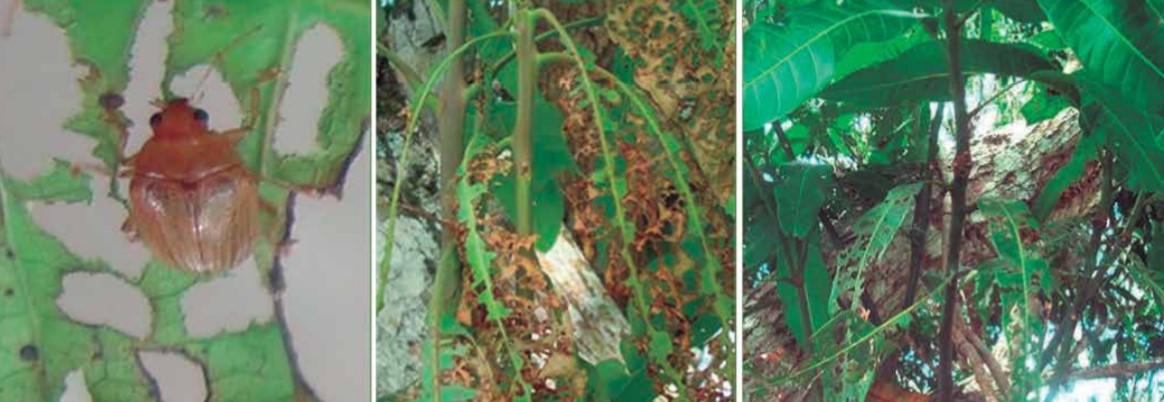Coquito damage to new mango shoots, in INIA Santa Bárbara, Monagas state
Abstract
The Monagas state stands out as one of the main mango producers, Manguifera indica L., contributing 15% to the national production. There are 22 Agricultural Production Units (UPA) with a productive area of 454 hectares which produce 6,145 tons, which represents a yield of 13,505 kg/ha, according to the VII Agricultural Census (MPPPAT, 2010).
Despite the fact that the mango tree is exuberant, it has low productive efficiency. Only a small percentage, less than 10% of the fruits formed initially, reach the harvest; to this is added the fact that only branches with more than 4 or
5 months old can produce flowers, depending on the cultivar and the same branch can present up to three vegetative growth flows in a year. For this reason, the practice of pruning is used for an early and greater emission of branches that allows to reduce the variability of flowering and to standardize the harvest. The defoliation of developing branches could stimulate a new disorderly vegetative growth, reducing the number of mature branches at the time of flowering, affecting the production of the following year.
The INIA Santa Bárbara experimental station is located in the Santa Bárbara municipality, at 09 ° 39 ’north latitude and 63 ° 27’ west longitude. It is located in the low mountainous part of the Monagas plains at 195 meters above sea level, it presents a tropical dry forest vegetation, with an average annual temperature of 26.8 ° C and rainfall of 1,092 millimeters (annual average). The soil in the experimental area corresponds to an Ultisol, characterized by having a sandy texture, acidic pH, low content of phosphorus, potassium and calcium (Rodríguez et al., 1996). The station has a small mango germplasm bank composed mostly of monoembryonic and some polyembryonic varieties, which would allow in the future the establishment of a nursery to support fruit growing in the area.
Among the foliage-consuming insects in mango cultivation reported in Venezuela are the bachaco Atta sexdens L, Photo 1; the spider worm Phobetron hipparchia Cramer, which eats leaves and buds irregularly; the chicken worm Megalopyge lanata Stoll, which feeds on the leaves; the coquito Lilophaeae auspicalis Bechyné, whose adults feed on the buds and the leaf-boring coquito Allocolaspis taylori Bechyné; Glyptoscelis fascicularis Baly and Costalimaita ferruginea (Fabricius, 1801).
References
com_content&task=view&id=460
Boscan, N. 1998. Insectos plaga del manguero. En FONAIAP, El cultivo del manguero en Venezuela (150-154 pp Capitulo VIII). Maracay.
Kassab, Samir., T. Mota., F. Pereira., P. Beltramin. 2011. Primero relato de Costalimaita ferruginea (Fabricius, 1801; Coleoptera: Chrysomelidae) em eucalipto no estado do Mato Grosso Do Sul. Ciência Florestal, Santa Maria , 21 (4), 777-780 pp. ISSN 0103-9954.
Menezes, I. (s.f.). Defesavegetal.net. Recuperado el 18 de Agosto de 2016, de Costalimaita ferruginea vulgata: http://www.defesavegetal.net/#!cosfev/c1j48
Mpppat. 2010. VII Censo Agrícola Estado Monagas. Maturin Edo. Monagas.
Pires, Evaldo., J. Corassa., M. Barreto., y M. Soares. 2013. New Report of Costalimaita ferruginea (Fabricius; Coleoptera: Chrysomelidae) on Eucalyptus sp. (Myrtaceae) in Sinop - Mato Grosso, Brazil. EntomoBrasilis, 6(1): 89-90 pp. Obtenido de: http://www.periodico.ebras.bio.br/ojs/index.php/ebras/article/view/207.doi:10.12741/ebrasilis.v6i1.207.Julio de 2016.
Rodríguez, M., D. Sanabria., U. Manrique., J. Fariñas., y E. Rivas. 1996. Efecto de Cinco Niveles de Nitrógeno sobre el Comportamiento de Digitaria Swazilandensis Stent en el Campo Experimental Santa Bárbara, Monagas. FONAIAP Monagas. Obtenido de http://
www.ceniap.gov.ve/pbd/RevistasCientificas/ZootecniaTropical/ zt1402/texto/nitrogeno.htm


